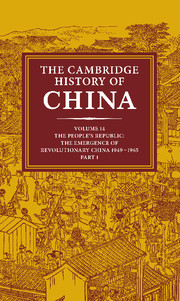Book contents
- Frontmatter
- 1 The reunification of China
- PART 1 EMULATING THE SOVIET MODEL, 1949–1957
- 2 Establishment and consolidation of the new regime
- 3 Economic recovery and the 1st Five-Year Plan
- 4 Education for the new order
- 5 The Party and the intellectuals
- 6 Foreign relations: from the Korean War to the Bandung Line
- PART II THE SEARCH FOR A CHINESE ROAD, 1958–1965
- Bibliographical Essays
- Bibliographical essays for chapters
- Bibliography
- Appendixes: Meetings and Leaders
- Conversion Tables: pinyin and Wade-Giles
- Glossary Index
- Map 1. China’s physical features
- Map 2. PRC: political (Wade–Giles romanization)
- Map 3. PRC: political (pinyin romanization)
- References
6 - Foreign relations: from the Korean War to the Bandung Line
from PART 1 - EMULATING THE SOVIET MODEL, 1949–1957
Published online by Cambridge University Press: 28 March 2008
- Frontmatter
- 1 The reunification of China
- PART 1 EMULATING THE SOVIET MODEL, 1949–1957
- 2 Establishment and consolidation of the new regime
- 3 Economic recovery and the 1st Five-Year Plan
- 4 Education for the new order
- 5 The Party and the intellectuals
- 6 Foreign relations: from the Korean War to the Bandung Line
- PART II THE SEARCH FOR A CHINESE ROAD, 1958–1965
- Bibliographical Essays
- Bibliographical essays for chapters
- Bibliography
- Appendixes: Meetings and Leaders
- Conversion Tables: pinyin and Wade-Giles
- Glossary Index
- Map 1. China’s physical features
- Map 2. PRC: political (Wade–Giles romanization)
- Map 3. PRC: political (pinyin romanization)
- References
Summary
AN OVERVIEW
On 1 October 1949 the broad united front that had supported the Chinese revolution became the basis of the regime headed by Mao Tse-tung. This newborn “People's democratic dictatorship” had to tackle the urgent task of reconstructing the Chinese economy, wrecked by foreign invasion and civil war. China was setting out on the road to socialist transformation.
The newly established People's Republic was quickly recognized by the Soviet Union, its East European satellites, and some Asian nations including India. Britain followed suit early in 1950. The new China was making a successful debut in the world.
China's top foreign policy goal was to develop good relations with its socialist “elder brother,” the Soviet Union. As early as December 1949, Chairman Mao personally led a delegation to Moscow in pursuance of the “lean to one side” policy he had outlined that summer. In February 1950, China and the Soviet Union signed a treaty of friendship, alliance, and mutual assistance, as well as a number of economic agreements. China initiated an economic development program on the Soviet model, with Soviet economic assistance and under the banner of Sino-Soviet friendship.
However, the Chinese got less from the Soviet Union than they had hoped. It is now known that they had long and difficult negotiations with the Kremlin leadership and that Stalin treated them rather coldly. In this respect, the one-time myth of the monolithic unity of Moscow and Peking certainly needs to be reexamined. In short, while following the Soviet model had been taken by the Chinese as a fundamental policy, there was tension between them and the Russians from the start.
Keywords
- Type
- Chapter
- Information
- The Cambridge History of China , pp. 259 - 290Publisher: Cambridge University PressPrint publication year: 1987
References
- 4
- Cited by

